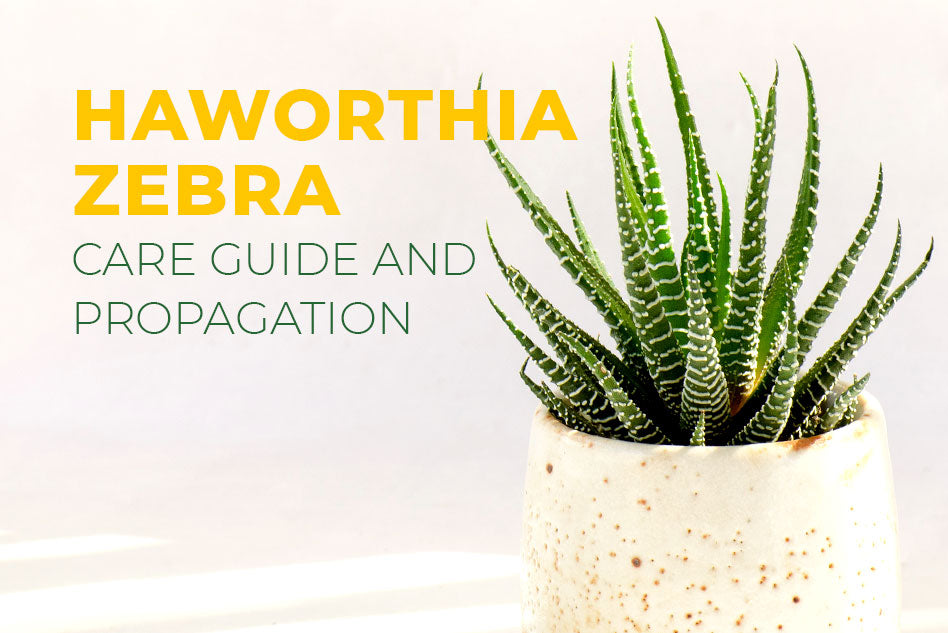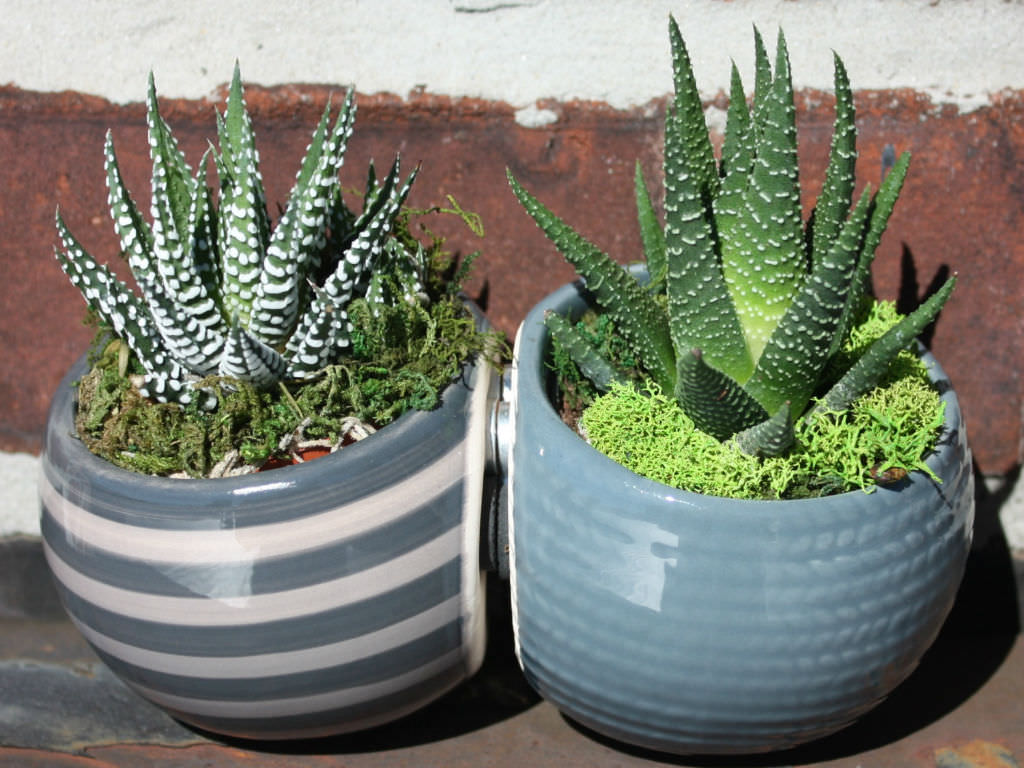Every two to three weeks, water zebra succulents. Place in a warm environment (between 55°F and 80°F) with bright indirect sunlight. Zebra succulents thrive indoors in pots with drainage holes and special succulent and cactus soil for the optimum drainage profile.
At maturity, Zebra succulents often measure 6 inches (15 cm) in height and width.
Zebra succulents, commonly referred to as zebra cactus (Haworthia fasciata), are very simple, low-maintenance plants that adapt well to growing as house plants indoors.
To maintain your plant healthy, keep reading to learn about the best methods for cultivating zebra succulents.
Profile of the Zebra Succulent Plant:
| Care/Requirements | Care for the Zebra Succulent (Haworthia fasciata) |
| Sun: | needs strong, indirect lighting. |
| Watering: | When the potting soil is totally dry, water. |
| The signs of overwatering are: | The texture of the leaves changes to a soft, mushy brown or yellow. |
| Underwatering signs and symptoms: | leaf tips that are brown. Lower leaves may get crunchy and brown. |
| Soil: | need lush soil that drains properly in order to avoid root rot. |
| Hardiness: | Grow inside if possible if you’re not in a region where frost is a problem. prefer dry weather. |
| Containers and Pots: | grows and reproduces successfully in pots and containers that match the size of the root ball. |
| Active Seasons for Growing: | grows more rapidly in the spring and fall when the weather is milder. |
| Dormancy: | When temperatures continuously above 80°F, plants can go into dormancy and use less water. Less light during the winter months can cause growth to slow. |
| preferred range of temperatures: | at room temperature, grows well. Ideal temperatures are between 55°F and 80°F (13°C and 27°C). |
| Feeding: | The best time to feed is in the spring and fall, when the plants are actively growing. |
| When Fully Maturity: | Slow-growing zebra succulents reach a compact height and width of about 6 inches (15 cm). |
Table of Contents
Watering Zebra Succulents (Haworthia fasciata)
Zebra succulent watering schedule:
Native to Southern Africa, zebra succulents can withstand drought and thrive in hot, arid climates with rocky soils and infrequent rainfall.
In order to successfully care for zebra succulents, mimic their natural watering cycle by watering generously so that excess water drips from the base of the container and then letting the soil entirely dry out in between watering sessions.
How frequently you water zebra succulents depends on how quickly your soil dries out, but in most houses, watering once every two weeks is sufficient to meet the plant’s hydration needs without leading to root rot.
By giving the plant a good soak and feeling the dirt at the bottom of the pot through the drainage hole in the base, you can determine the ideal watering schedule for zebra plants in your house.
Delay watering for a few days if the soil feels wet or damp; otherwise, this is the ideal time to water your zebra succulent.
Zebra succulent watering recommendations:
Always water deeply enough so any extra water trickles out of the pot’s bottom.
In order for the roots to absorb the hydration they need, this guarantees that the water has permeated the soil.
Symptoms of excessive irrigation
Zebra plants are more vulnerable to overwatering than underwatering because they are suited to surviving in dryer conditions.
An overwatered zebra succulent will show signs of stress by turning its leaves brown or yellow and making them feel mushy and soft. The leaves may also sag to the ground.
If this occurs to your zebra succulent, stop watering it right away and let the soil dry up. If the soil retains wet for extended periods, think about replacing it because this leads to root rot.
If your plant appears sick, (read my post on how to resuscitate a dying zebra plant).
Underwatering signs and symptoms:
Underwatering, particularly low humidity, or excessive air flow from draughts, air conditions, forced air, or any other air currents can cause the leaf tips to become dry.
When underwatering causes severe drought stress, the lower leaves may turn brown and crunchy. In times of drought, the water-storing thick, plump leaves tend to become thinner.
(Learn more about zebra succulent brown leaf tips by reading my article.)
Your zebra succulent should recover after two or three cycles of watering if you increase watering (as long as the soil dries out a little between bouts of watering), water with a generous soak, and place the plant somewhere without strong air currents.
(To learn about all the best watering techniques, see my article on how to water a zebra succulent.)
Best Soil for Zebra Succulents
On their native South Africa, zebra succulents thrive in rocky, well-draining soils, therefore it’s critical to mimic similar soil characteristics when growing them indoors.
Plant your zebra succulent, ideally, in specially formulated succulent and cacti soil that has been made to resemble the original soil conditions of the plant, ideally with a high particle size and a well-draining porous structure.
The roots of your drought-adapted zebra plant tend to retain moisture in regular potting soil for an excessively long time, which can have the same effects as overwatering and encourage root rot.
Locate Zebra Succulents in Bright, Indirect Light
Zebra succulents typically thrive in shaded regions that are sheltered from the sun by rocks or other vegetation in their natural habitat.
Zebra succulents can only grow in areas with adequate shelter and bright light since the sun is so fierce in their native range of South Africa.
As long as it’s not in direct sunlight on a window sill, where it could become red or white as a sign of stress, the zebra succulent’s preference for bright light makes it a superb adaptable house plant.
The zebra succulent features striking white stripes and a deep green color in ideal lighting.
Pots and Containers for Zebra Succulents
The zebra succulent is more likely to develop root rot if the pot or container is too large since it may take too long for it to dry out.
Make sure the pot has a drainage hole in the bottom to let excess water drain out so the soil can properly dry out in between watering sessions.
Zebra succulents can thrive in any kind of container, but clay or terracotta pots are thought to be the ideal because they are a bit porous and let the soil to dry up more quickly than plastic containers do.
The recommended approach is to re-pot zebra plants into a pot that is a size larger to avoid roots clogging drainage holes and causing water to drain too slowly. Zebra plants may withstand being somewhat root-bound.
Repotting can be done at any time of year, but it is best done in the spring.
Active Growth and Summer Dormancy of Zebra Succulents
Zebra succulents can go into hibernation in the summer when the temperature is high as a means of surviving the harsh environment in their native South Africa.
The zebra succulent slows down development in order to preserve resources, especially water, when summertime temperatures consistently surpass 80°F (27°C).
Because the plant requires less water when it is dormant, the root system may be more vulnerable to rot.
Therefore, you shouldn’t necessarily water your zebra succulent more often in the summer, especially if the temperature is high.
The plant can resume active growth when the weather cools, as long as the soil dries out between waterings and the zebra is placed in a pot that is appropriate for its size.
As there is a balance between bright sunshine and cooler temperatures in the spring and fall, zebra succulents grow more quickly (although they still grow slowly).
They are more likely to produce off-sets that can be used for propagation in the spring and fall.
Due to shorter daylight hours, zebra succulent growth can be slower in the winter. In the winter, water zebra succulents once every three to four weeks.
Optimal Temperature Range and Rate of Growth
The ideal temperature range for zebra plant growth is roughly 55°F-80°F (13°C-27°C).
The plant goes dormant to conserve moisture if the temperature rises above this range. The plant can endure occasional cold if the temperature is within the ideal range, but it will likely die back in frost.
Even for succulents, zebra succulents grow slowly, eventually growing to a compact size of 6 inches (15 cm) in height and width.
Avoid direct sunlight as it might burn the plant. Instead, place zebra succulents in bright, indirect light. If you want to speed their growth, use a grow lamp for a few extra hours each day.
Fertilizer for Zebra Succulents
However, for good growth, fertilizer can be applied during the growing season, especially in the Spring and Fall.
To minimize issues with overfeeding your succulents, I personally like to use a specialized succulents and cactus fertilizer (available from garden centers and Amazon). It has all the nutrients that zebra plants need at the proper percentages.
While the succulent is not developing as vigorously in the winter or during the summer’s high temperatures, avoid fertilizing.
Key Takeaways:
- – Causes. Too much sun. Zebra succulents thrive in bright, indirect light.
- Moderate Watering Once a week or so in Summer and once every two weeks in Winter. Feeding Try to fertilise once every three months when it’s growing.
- To allow excess water to drain from the pot and let the soil to properly dry out in between watering sessions, make sure the pot has a drainage hole in the base.
- Zebra succulents can thrive in any kind of container, but clay or terracotta pots are thought to be the ideal because they are a little bit porous and let the soil to dry up more quickly than plastic containers do.
FAQ
How long do zebra succulents live?
Zebra plants can handle having some root encroachment, but it’s preferable to repot them into a larger pot to avoid having roots obstruct the drainage holes and cause the water to drain too slowly.
How much sun does a zebra succulent need?
While any time of year can be successfully used for re-potting, spring is the optimum period.
How do I know if my zebra succulent is dying?
In order to survive in their native South Africa’s harsh climate during the summer when temperatures are high, zebra succulents can go into dormancy.
How often do you water zebra succulents?
In order to save its resources, mainly water, the zebra succulent slows down growth when summertime temperatures consistently surpass 80°F (27°C).
How do you water a zebra succulent?
As the plant requires less water when in a dormant state, it may be more vulnerable to root rot.


